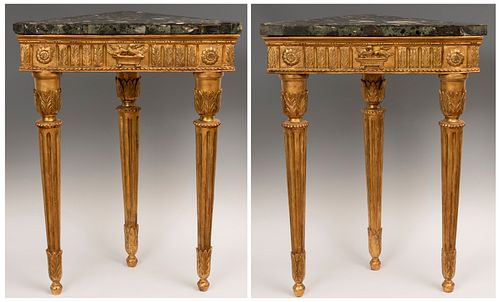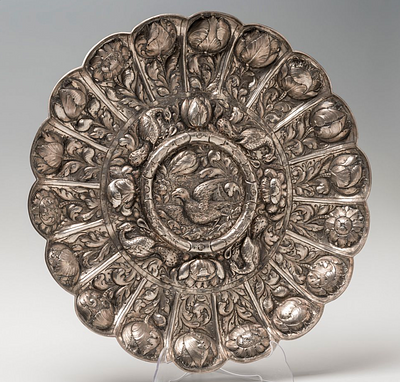Pair of Louis XVI style consoles; Rome, last third of the eighteenth century. Carved and gilded wood and original green marble veneer.
Lot 42
About Seller
Setdart Auction House
Carrer Aragó 346
Barcelona
Spain
Setdart Subastas was born in 2004 and is currently the first online art auction in Spain with solidity, prestige and reliability guaranteed by our more than 60,000 users. Setdart has a young, dynamic and enterprising team ready to successfully manage the purchase and sale of art works through custom...Read more
Categories
Estimate:
EUR€20,000 - EUR€25,000
$21,739.13 - $27,173.91
Absentee vs Live bid
Two ways to bid:
- Leave a max absentee bid and the platform will bid on your behalf up to your maximum bid during the live auction.
- Bid live during the auction and your bids will be submitted real-time to the auctioneer.
Bid Increments
| Price | Bid Increment |
|---|---|
| EUR€0 | EUR€10 |
| EUR€200 | EUR€25 |
| EUR€500 | EUR€50 |
| EUR€1,000 | EUR€100 |
| EUR€3,000 | EUR€200 |
| EUR€5,000 | EUR€500 |
| EUR€10,000 | EUR€1,000 |
| EUR€20,000 | EUR€2,000 |
| EUR€50,000 | EUR€5,000 |
About Auction
By Setdart Auction House
Jul 13, 2021
Set Reminder
2021-07-13 07:00:00
2021-07-13 07:00:00
America/New_York
Bidsquare
Bidsquare : DECORATIVE ARTS XV-XIX
https://www.bidsquare.com/auctions/setdart-auction-house/decorative-arts-xv-xix-7201
Setdart Auction House sofia@setdart.com
Setdart Auction House sofia@setdart.com
- Lot Description
Pair of Louis XVI style consoles; Rome, last third of the eighteenth century. Carved and gilded wood and original green marble veneer. Measures: 93 x 75 x 35 cm. Pair of consoles with the same structure of triangular board made of green marble. This board rests on three legs made of carved and gilded wood. They have a structure that supports its base on a ball, from which a carved element of vegetal physiognomy, which gives way to the fluted shaft. This shaft ends in an ornamentation based on small balls that run around the perimeter, and give rise to another decorative element in the form of a cup with acanthus leaves. Finally the skirt of the table is arranged, which presents a relief following models of Roman mosaics, with palmettes, rosettes and in the center the figure of two doves. The Louis XVI style, which flourished in France in the second half of the 18th century, was inspired by classical antiquity and was one of the most representative of Neoclassicism. This fame and value meant that, subsequently, it continued to be one of the most frequent sources of inspiration for other objects. The realization of consoles was widely recognized in Rome between the second half of the seventeenth century and the beginning of the eighteenth century, and derived directly from those made during the early Baroque by artists in Bernini's immediate environment, such as the famous tables of the Naiad and the Triton. These were pieces of furniture where carving predominates, worked at various levels of relief and even with details in round bulge, independent figures that can replace parts of the structure (especially the supports). These tables were display furniture, richly decorated and characterized by a high quality. On the other hand, as they approach the 18th century, as in this particular case, more and more symmetrical forms will be seen in them, seeking undulation, movement, but also a certain balance, as can be seen in this piece, and prioritizing vegetal decoration.
- Shipping Info
-
In-house shipping available. Please inquire at admin@setdart.com.
-
- Buyer's Premium



 EUR
EUR CAD
CAD AUD
AUD GBP
GBP MXN
MXN HKD
HKD CNY
CNY MYR
MYR SEK
SEK SGD
SGD CHF
CHF THB
THB
















